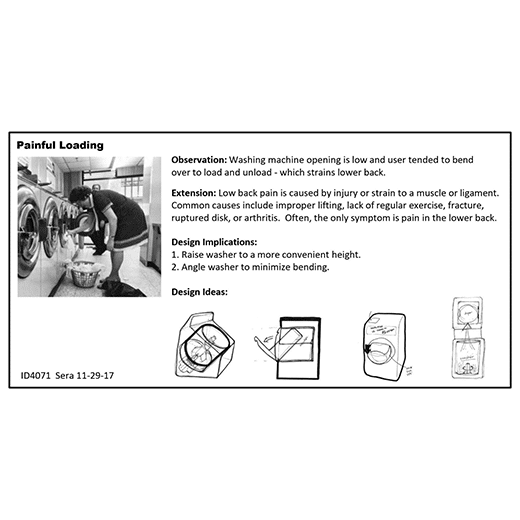IDSA publishes a selection of peer-reviewed academic education papers each year. These are collected during a community-wide open call period when design educators and practitioners submit materials for review by a group of judges serving on IDSA’s Academic Jury. The program also helps provide content for the annual Education Symposium, where some authors are invited to present their work from the stage to a live audience. To view the full Education Papers jury please visit meet the jury page.
Guidelines for Practitioners and Critics
The goal of experimental and discursive design is not to create products ready for release, but instead to use design to explore new techniques, materials and products or serve as provocations for discussion, unconstrained by the usual burdens of
Author: Kristiaan Brauer
Company / School: University of Washington
- 2023
- Paper Type: Student Research
- Research Status Work in Progress
- Education Symposium Theme: The Watering Hole
Expanding Vision in Student Projects
My previous article from the 22nd DMI Academic Design Management Conference, The Success and Challenges of the Double Diamond in Studio Projects1, went into detail describing the nuances of the Double Diamond design process. One request from that publication
Author: Herb Velazquez
Company / School: Georgia Institute of Technology
- 2023
- Paper Type: Academic Research
- Research Status Work in Progress
- Education Symposium Theme: The Watering Hole
Application of Upholstery in Vehicle Interiors for Their Development into the Third Living/Workspace
The purpose of this study is to investigate design opportunities for industrial designers in the field of automotive interiors, with a focus on the integration of smart textiles. The research examines current trends and innovations in automotive interior design
Author: Benjamin Doffing, Gavin Garrett, Byungsoo Kim
Company / School: Kansas State University
- 2023
- Paper Type: Student Research
- Research Status Work in Progress
- Education Symposium Theme: The Watering Hole
A User Experience Research and Product Sketch Practice in Industrial Design Education with Augmented Reality (AR) Technology
Understanding users and analyzing their needs is a commonly required skill during the research phase of the design process and designing a product. However, researching real users can be challenging for students in the early stages of the industrial
Author: Jung Joo Sohn, Nickolas Guo
Company / School: Purdue University
- 2023
- Paper Type: Case Study
- Research Status Work in Progress
- Education Symposium Theme: The Watering Hole
An Interactive Exploration and Critique of Design Thinking
Over the past several decades, the practice of design has benefited from tremendous growth in interest, study, and application. The principles, practices, and methods of design, often summed up simply as “design thinking,” have been adopted by an increasingly
Author: James Rudolph, Sarah Edmands Martin
Company / School: University of Notre Dame
- 2023
- Education Symposium Theme: The Watering Hole
Industrial Design Education (IDE) is a delicate balance between developing skills (practices and methods) and nurturing creativity (developing opportunities). Assigned projects need to emphasize, to varying degrees, both skills and creativity. There are two main constituencies within IDE, educators
Author: Adam Feld
Company / School: University of Louisiana at Lafayette
- 2023
- Paper Type: Academic Research
- Research Status Work in Progress
- Education Symposium Theme: The Watering Hole
How to Create a Stronger ‘Brand-User’ Connection?
The increasing impact of technology and the integration of AI in the creative industries have sparked discussions about the value of traditional craftsmanship and originality. In this changing landscape, design education plays a crucial role in educating students to
Author: Chunshik Kim
Company / School: Savannah College of Art and Design
- 2023
- Paper Type: Case Study
- Research Status Work in Progress
- Education Symposium Theme: The Watering Hole
A Study to Rehabilitate and Enhance the Design Education and its Spaces
In this study, the impacts of lighting design to productivity and motivation in design education’s spaces are analyzed and models are tested. Physiological and psychological effects of designing task-specific spaces are examined. Lighting systems are known to have great
Author: Mekin Elcioglu, PhD, Yesim Celikkol
Company / School: Kansas State University, Mimar Sinan Fine Arts University
- 2023
- Paper Type: Academic Research
- Research Status Work in Progress
- Education Symposium Theme: The Watering Hole
Reducing Food Waste at Retail Stores – An Explorative Study
This study focuses on the problem of food waste in grocery stores in rural America and in food deserts, and the opportunities for designers to address these issues. Previous research has emphasized the need for food loss and waste
Author: Amanda Sencenbaugh, Tyler Hilk, Byungsoo Kim
Company / School: Kansas State University
- 2023
- Paper Type: Student Research
- Research Status Work in Progress
- Education Symposium Theme: The Watering Hole
A Wristband Connected to an App Designed for Navigating Cooking for Visual Impaired People
Cooking alone can be challenging for visually impaired people. Previous research has shown that people with visual impairment are more likely to have difficulty shopping for, preparing, and eating food. Because of the lack of vision and reduced ability
Author: Na Zhuo
Company / School: Purdue University
- 2023
- Paper Type: Student Research
- Research Status Completed
- Education Symposium Theme: The Watering Hole









